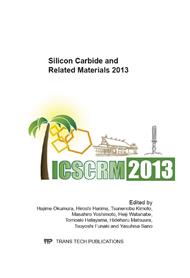p.402
p.407
p.414
p.418
p.424
p.428
p.432
p.436
p.440
Deep-Level Transient Spectroscopy Characterization of Interface States in SiO2/4H-SiC Structures Close to the Conduction Band Edge
Abstract:
Constant-capacitance deep-level transient spectroscopy was carried out to characterize in detail interface states close to the conduction band edge in SiO2/SiC structures. The measured results are summarized as follows: (1) The capture of electrons by the interface states proceeds logarithmically with time. (2) The emission of electrons accelerates slightly with increasing density of captured electrons. The oxide trap model explains the logarithmic change in capture with time but not the phenomenon of accelerated emissions. This prompted us to formulate a new model that replicates the logarithmic capture process with time. In this model, we postulated the electron density at the interface decreases exponentially as the trapped electron density increases owing to the interaction between the trapped electrons and the free electrons. In this case, the capture process is almost the same as with the oxide trap model except for the definition of parameters. Further, we do not need to take into account the delay of the emission process caused by tunneling. The phenomenon of accelerated emissions may be explained by interactions among captured electrons in this model.
Info:
Periodical:
Pages:
424-427
Citation:
Online since:
February 2014
Keywords:
Price:
Сopyright:
© 2014 Trans Tech Publications Ltd. All Rights Reserved
Share:
Citation:


